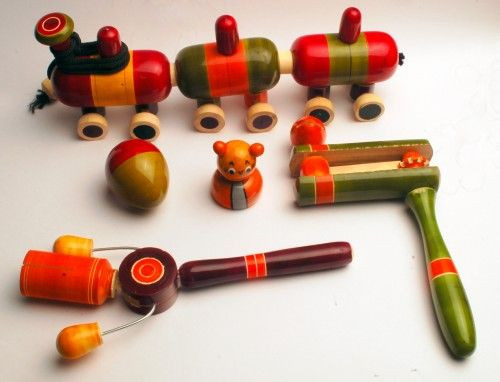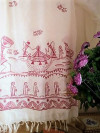Being the cradle of variety and diversity, India is a land of several indigenous games and toys. They are not only sources of merriment but also the reflections of the art and culture of a particular area of the country. The wide range of such games includes playing with different types of indigenous dolls, blocks, puzzles, board games, and outdoor games like Kabaddi, Kho Kho, Gilli Danda. In this article, we will throw some light on such indigenous games and toys of India in detail.
History of Indian Traditional Games and Toys
Archaeological findings have proved the existence of toys since Indus Valley Civilization. Toys like toy carts, dancing women, etc. made of terra cotta or metal alloys like Bronze were found. Epics like Ramayana and Mahabharata also include depictions of games and toys played by the Princes and Royalty which were mostly board games. The Swadeshi Movement popularised Indian traditional toys countering the factory-made toys imposed by the British during the Indian Freedom Struggle.
Different Traditional Games Of India
- Lattoo: It is one of the most common Indian traditional games. It literally means the spinning top. The game is to make the top spin for the longest time by throwing the Lattoo. It consists of a circular body attached to a nail at the bottom and a string is wrapped around the top of the crown allowing the player to spin the top when thrown. It is one of the oldest indigenous toys of India and was primarily made of clay. Later around 2000 BC, wooden tops were introduced. At present, spinning tops made of plastic components are also found.
- Marbles: Marbles, also known as Golli, Guli, Goti, Lakhoti, Kancha, etc are other popular traditional game which is supposed to have evolved during the Harappan Civilization. This game involves the usage of many circular glass marbles and the participation of many people. The marbles should be spread on the ground and one has to strike them with a chosen marble. If anyone succeeds in striking all the marbles, then the person can carry back home all of them with him.
- Miniature Kitchen Sets: These are the oldest toys specifically made for girls. Known by various names like Bhatukali, Ranna Bati, etc, these toys aim at teaching and training young girls various household chores and home management techniques through games. The toys in these kitchen set consist of different cooking utensils, miniature ovens, and other household objects like chair tables, tea cups, and plates, etc. Such toys were primarily made of metal alloys like brass, wood, burnt clay, or Terracotta but nowadays they are also made of Aluminium and plastic fibre.
- Blocks and Puzzles: There is evidence of numerous types of blocks and puzzles which were played in the ancient times to sharpen one's intellect and increase concentration. Puzzles like Diagonal bars, Snake Cube, Labyrinth, Scrabbles and blocks like Interlocking Blocks, Building Blocks, Cubes etc were all used for playing. These puzzle and block games are still relevant and found to be played in many places across the country. They are mostly made up of wood. Clay and Terracotta made puzzles and blocks are also found.
Outdoor Games
- Kabaddi: It is the most popular outdoor traditional game believed to have originated during the Vedic Era. It is a body contact team game played between two teams of seven players. The objective of the sport is to run out all the players of the opposite team without being tackled by the defender in a single breath. At present, Kabaddi has garnered international appreciation and it is enlisted as a medal event in the Asian Games. The International Kabaddi Federation organizes the Kabaddi World Cup.
- Kho Kho: It is an ancient outdoor game that originated in Maharashtra. Primarily, it was played using chariots. The modern version involves two teams consisting of 12 players among which 9 players of one team will sit on their knees and 3 defenders who will try to avoid being touched by opponent players. It is now a popular game in many countries and numerous domestic and international Kho Kho Championships are held every year.
- Polo: Polo or Chaughan was introduced in India by the Turkish rulers of the Delhi Sultanate. It is a ball game on horseback played between two teams consisting of four riders where the players use a long wooden stick called a mallet to score goals. Polo has mostly been the 'Game of the Kings' since everyone cannot afford a horse although this sport has always gathered huge spectators. The modern polo game has also originated from Manipur, India, and Imphal has the oldest polo ground in the world.
- Hopscotch: A well-known childhood game in the world, in India Hopscotch, is referred to as Nondi, Kith Kith, Stapoo, etc. The players make numbered grids on the ground and throw stones on them. Then the player has to hop with one or both legs according to the grid pattern to the box where the stone has landed without touching the edge of the box.
- Gilli Danda: It is the Indian version of the fusion of modern cricket and baseball. It is played among four or even number players. Two different sizes of sticks are used. The smaller stick or Gilli is hit by the longer stick or Danda to the farthest distance possible and the player who hit the Gilli has to run to a particular point before the opponent player finds the stick.
- Kite Flying: It is a very popular game in several states of India. Here they are generally made of a single string, paper, and bamboo and are highly maneuverable. Kites are flown from rooftops, open fields or roadside and the flyers use the technique of line friction to cut each other's line. Although kites are flown almost throughout the year, they flew during festivals like Makar Sankranti, Viswakarma Puja, Uttarayan, Republic Day and Independence Day. The Kite and its string making is also a big industry in India and the International Kite Festival is held every year in Gujarat.
Picture Source: Pinterest



